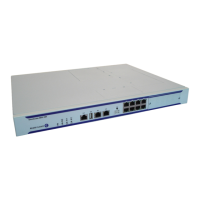Configuring Ports
Page 156 7750 SR OS Interface Configuration Guide
After the active bandwidth is calculated for the port, the result may be modified through the use of
the ‘ing-percentage-of-rate’ and ‘egr-percent-of-rate’ commands. The default value of each is
100% which allows the system to use all of the ports active bandwidth when deciding the relative
amount of buffer space to allocate to the port. When the value is explicitly modified, the active
bandwidth on the port is changed according to the specified percentage. If a value of 50% is given,
the ports active bandwidth will be multiplied by .5, if a value of 150% is given, the active
bandwidth will be multiplied by 1.5. This capability is independent of named pool mode. The
ports rate percentage parameters may be modified at any time.
Examples:
1. To modify (in this example, to double) the size of buffer allocated on ingress for a port:
CLI Syntax: B:SR7-10# configure port 1/2/1 modify-buffer-allocation-rate
ing-percentage-of-rate 200
2. To modify (in this example, to double) the size of buffer allocated on ingress for a
port:
CLI Syntax: B:SR7-10# configure port 1/2/1 modify-buffer-allocation-rate
egr-percentage-of-rate 200
Named Buffer Pools feature provides a way to customize the port ingress and/or egress buffer
allocation. The port buffer allocation size and Forwarding class (FC) queue association to the
buffer pool may be changed. By mapping each FC to different pools, it is possible to achieve
separation of available buffers per forwarding class.
Previous to this feature only the default buffer allocation mode was available, with the following
characteristics:
• Each port manages a buffer according to its active bandwidth (ports with equal active
bandwidth get the same buffer size)
• An access port has 2 default pools created: access-ingress and access-egress
• A network port has 2 default pools created: ingress-MDA (common pool for all ingress
network ports) and network-egress
• All queues defined for a port get buffers from the same buffer pool.
Named Buffer Pools feature offers the following new capabilities:
• Ability to modify the port bandwidth considered for buffer allocation without changing
the active port bandwidth. (modify-buffer-allocation-rate) (ports with equal active
bandwidth can be configured to get different buffer size)
• Configure a named pool policy which includes the customized buffer pools
• Forwarding class queues are associated with the named pools
• Pools can be default, MDA common pools, port specific pools.

